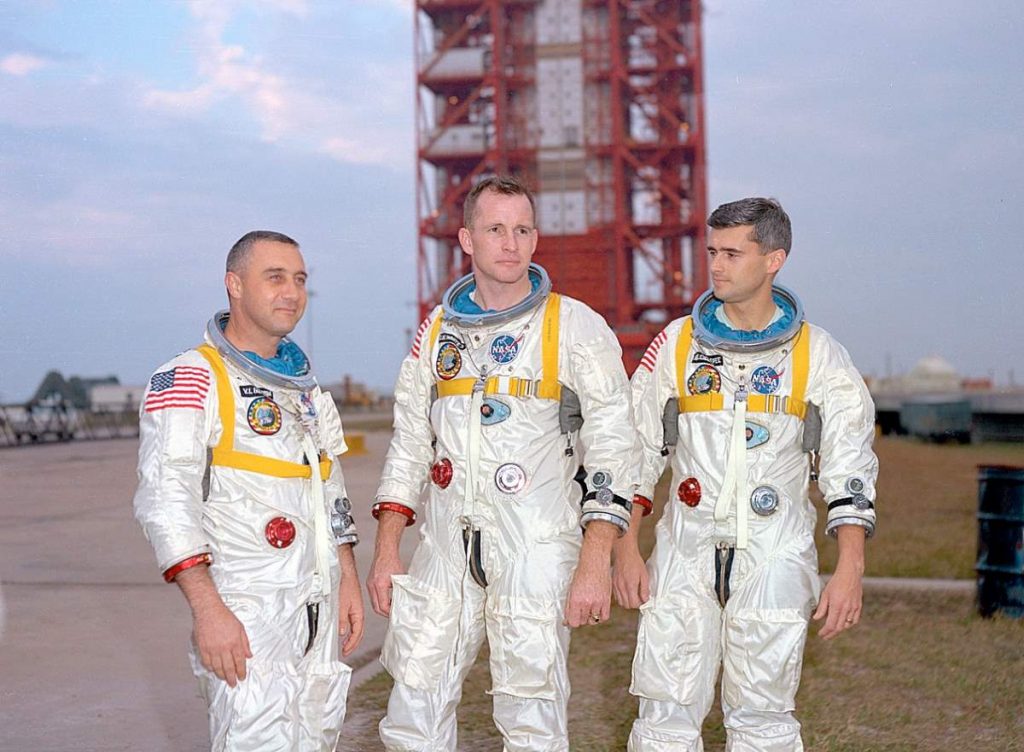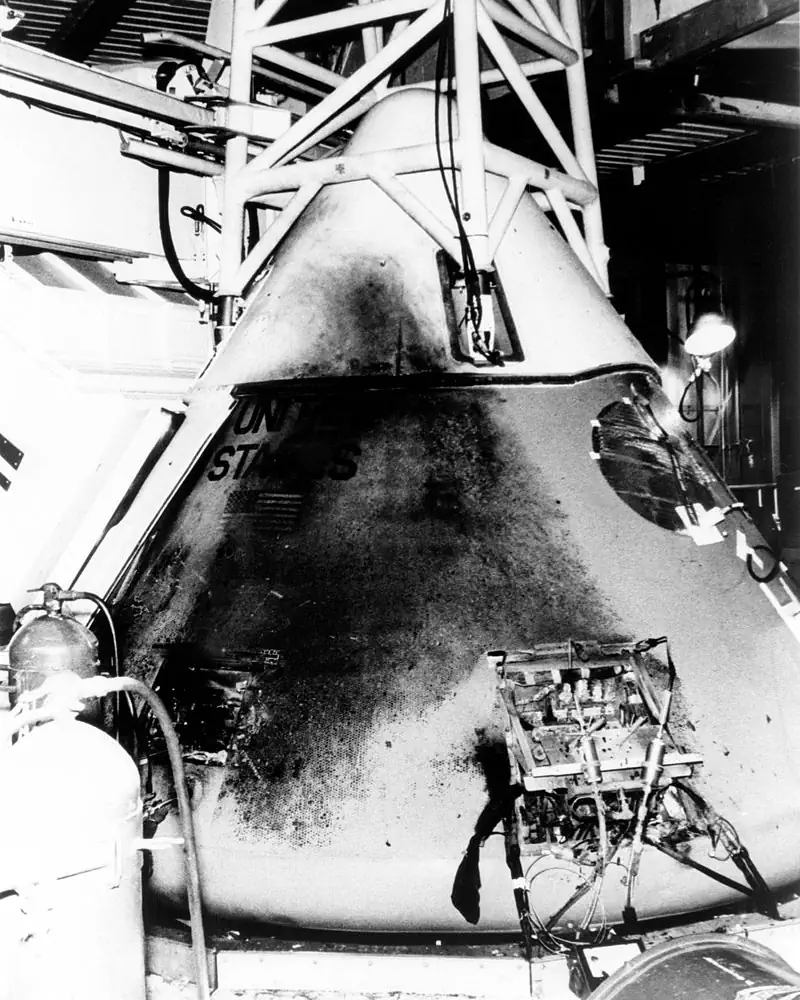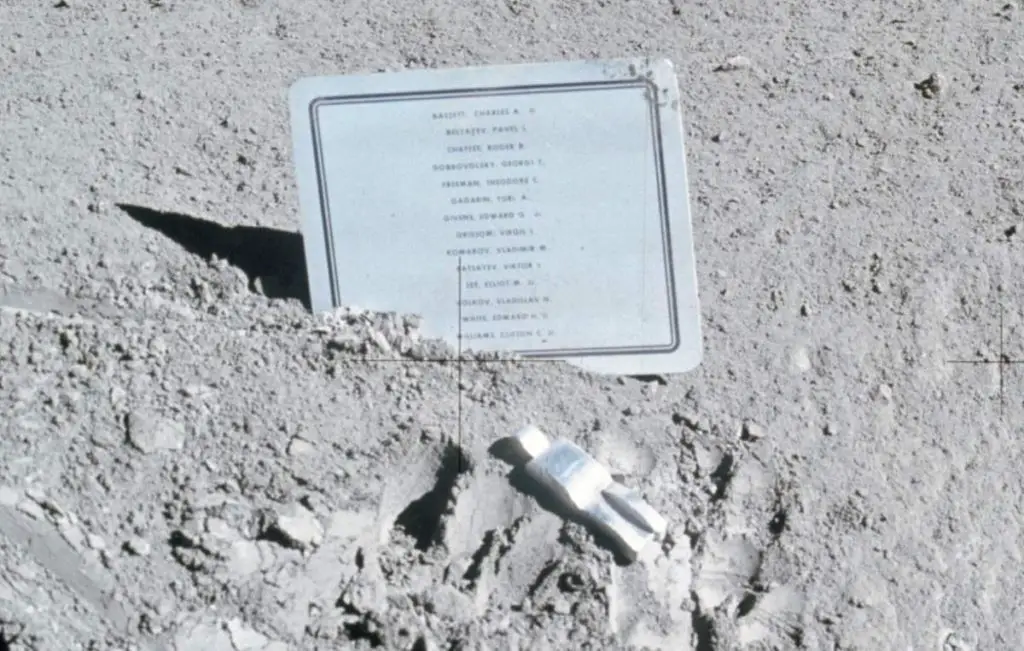On January 27, 1967, three NASA astronauts, Roger B. Chaffee (b. February 15, 1935), Virgil I. Grissom (b. April 3, 1926), and Edward H. White II (b. November 14, 1930) died when a flash fire swept through the Apollo 1 command module during a launch rehearsal test. The three men inside perished despite the best efforts of the ground crew. It would take more than 18 months, and extensive redesigns, before NASA sent more astronauts into space.
January 27 story of what happened this day in Science, Technology, Astronomy, and Space Exploration history.
Apollo 1
Initially designated AS-204, Apollo 1 was intended to be the first crewed mission of the United States Apollo program, the American undertaking to land the first human being on the Moon, announced on May 25, 1961, by John F. Kennedy, the 35th president of the United States.
The flight of Apollo 1 was scheduled for February 27, 1967. On January 27, three astronauts, Virgil I. Grissom, Edward H. White, and Roger B. Chaffee, clad in their spacesuits inside their Command Module (CM) at Cape Kennedy’s Launch Complex 34, were conducting a countdown simulation ahead of their planned spaceflight, which would be the first crewed Apollo flight.
At 1:00 pm, the three astronauts entered the command module (CM) fully pressure-suited, and were strapped into their seats and hooked up to the spacecraft’s oxygen and communication systems.

Upon entering the cabin, Grissom immediately noticed a strange odor which he compared to “sour buttermilk”. Because of this, the simulated countdown was postponed and put on hold at 1:20 pm.
Air samples taken but nothing could be found. This investigation took longer than expected, and the simulated countdown was resumed at 2:42 pm.
Three minutes after the countdown was resumed, astronauts and ground crews sealed the three hatches of the Apollo CM capsule and pressurized it with pure oxygen at 16.7 pounds per square inch (psi), slightly higher than atmospheric pressure, as they would on launch day one month later.
Because of a communication problem, the simulated countdown was put on hold again at 5:40 pm. This and a free minor problems successfully solved by 6:20 pm, and at 6:30 the count remained on hold at T minus 10 minutes.
Tragedy strikes
At 6:30:56 p.m, when the crew members were using the time to run through their checklist again, a momentary increase in AC Bus 2 voltage occurred. Just nine seconds later, at (at 6:31:04.7), one of the astronauts (some listeners and laboratory analysis indicate Grissom) exclaimed “Hey!”, “Fire!”, or “Flame!”;
Suddenly, flash fire broke out inside the cabin. Within seconds, rising temperatures and pressures caused the CM pressure vessel to crack, releasing flames and smoke onto the launch pad’s service structure.
At 6:31:06.2, someone (believed by most listeners, and supported by laboratory analysis, to be Chaffee) said, “[I’ve, or We’ve] got a fire in the cockpit.” After 6.8 seconds of silence, a second, badly garbled transmission was heard by various listeners as:
- “They’re fighting a bad fire-Let’s get out… Open ‘er up”,
- “We’ve got a bad fire-Let’s get out… We’re burning up”, or
- “I’m reporting a bad fire… I’m getting out…”
The transmission lasted 5.0 seconds and ended with a cry of pain.
The astronauts, in vain, attempted to open the inner hatch, while the pad crew valiantly worked to open the outer two hatches, their attempts hampered by dense smoke and heat.
By the time they opened the hatches, the crew had already perished. Later that night, after photographers fully documented the scene, recovery crews removed the astronauts’ bodies from the spacecraft and took them to a nearby medical facility. U.S. Air Force pathologists conducted examinations, concluding that the astronauts died of asphyxia from carbon monoxide and other toxic gases resulting from the fire. The burns they received were likely survivable.
Aftermath

The Apollo program changed forever after the incident. The improvements in astronaut safety allowed the agency to complete the rest of the program with no further fatalities. The agency also met United States president John F. Kennedy’s goal of landing a man on the moon in a decade, with Apollo 11 in 1969.
On August 2, 1971, during the third EVA (Extravehicular activity), the Apollo 15 astronauts left on the surface of the Moon a tiny memorial statue, nicknamed Fallen Astronaut, along with a plaque containing the names of the Apollo 1 astronauts, among others including Soviet cosmonauts, who perished in the pursuit of human spaceflight.

Apollo 1 name
In the spring of 1967, NASA’s Associate Administrator for Manned Space Flight, Dr. George E. Mueller, announced that the mission originally scheduled for Grissom, White, and Chaffee would be known as Apollo 1, and said that the first Saturn V launch, scheduled for November 1967, would be known as Apollo 4. The eventual launch of AS-204 became known as the Apollo 5 mission. No missions or flights were ever designated Apollo 2 or 3.
Condolences to the Apollo 1 accident
“Three valiant young men have given their lives in the nation’s service. We mourn this great loss and our hearts go out to their families.” President Lyndon B. Johnson
“The deaths of these three brilliant young men… is a profound and personal loss to me…. The United States will push ever forward in space and the memory of the contributions of these men will be an inspiration to all future space-farers.” Vice President Hubert H. Humphrey
“We’ve always known that something like this would happen sooner or later, but it’s not going to be permitted to stop the program…. Although everyone realized that someday space pilots would die, who would have thought the first tragedy would be on the ground?” NASA Administrator James E. Webb (Note: To date, only 3 people died in space)
“The accident that took the lives of three of our highly trained, skilled and courageous American astronauts is a tragic loss to our entire nation.” Former President Dwight D. Eisenhower
“We in the Soviet Union are deeply grieved at the news of the tragedy at Cape Kennedy. The courage of Virgil Grissom, Edward White, and Roger Chaffee had won our esteem and we join in paying homage to their memories.” Radio Moscow
Sources
- The Apollo 1 Fire and its Aftermath on the NASA website
- Apollo 1 Tragedy on the NASA website
- Apollo 1 on Wikipedia
- Final Preparations for the Planned Launch of Apollo 1 on the NASA History website
- Moon Landings: All-Time List [1966-2025] - February 2, 2025
- What Is Max-Q and Why Is It Important During Rocket Launches? - January 16, 2025
- Top 10 Tallest Rockets Ever Launched [2025 Update] - January 16, 2025
